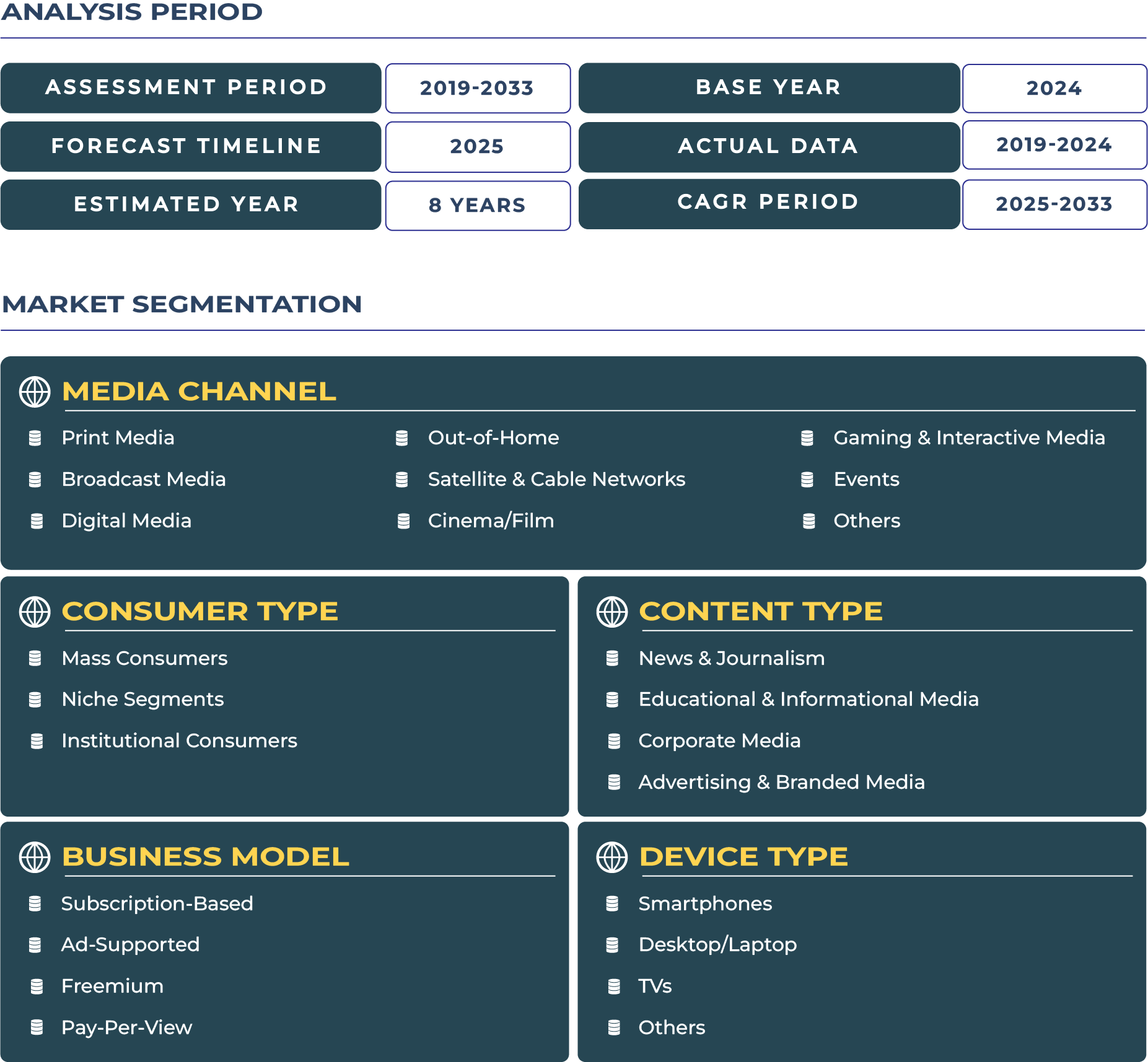Hong Kong Media Market Outlook
Dynamic Growth Anchored by Economic Strength and Consumer Sophistication
The media industry in Hong Kong has long mirrored its status as a global financial and cultural crossroads. With a resilient economy and high GDP per capita—projected at over US$ 52,000 in 2024—Hong Kong media sector is uniquely positioned for digital acceleration. The forecast period from 2025 to 2033 suggests a compound annual growth rate (CAGR) of X.2%, driven by rising disposable income and expanding digital ad spend, which is expected to surpass US$ XX.1 billion by 2033. Advertisers are increasingly allocating budgets toward personalized, programmatic, and influencer-led campaigns, reflecting the region’s digitally mature and affluent consumer base. As a global hub with bilingual capabilities (English and Cantonese), Hong Kong offers fertile ground for both international media giants and local storytellers.
Cross-Media Preferences Shaped by Demographics and Device Penetration
Media consumption in Hong Kong reflects a diversified demographic landscape. With over 92% internet penetration and smartphone ownership among all age groups, digital-first platforms dominate, particularly among Millennials and Gen Z. Streaming video content, short-form videos, podcasts, and social news apps such as HK01, ViuTV, and YouTube are now preferred over traditional formats. However, older Gen X and Baby Boomers continue to rely on established channels like TVB, RTHK, and the South China Morning Post (SCMP) for daily news and cultural content. Multilingual media offerings and the proliferation of cross-border Mandarin content from Mainland China also shape viewing habits, with OTT services like iQIYI and Tencent Video entering the Hong Kong market with subtitled, culturally tailored offerings.
Media Channels: From Traditional Pillars to Digital Trailblazers
Television remains a pillar in Hong Kong media, but its format has undergone a significant transition. TVB, Hong Kong’s leading free-to-air broadcaster, has made aggressive moves to shift from linear TV to digital VOD through TVB Anywhere. In 2023, it partnered with YouTube to broaden its monetization channels and reach diaspora audiences globally. Meanwhile, ViuTV, a growing challenger, strengthened its market share by championing local music, reality TV, and drama tailored to the tastes of Gen Z. On the print and online news front, SCMP continues to innovate digitally, launching AI-enhanced newsroom capabilities in 2024 to boost user personalization and engagement.
Social media platforms like Instagram, Facebook, and Xiaohongshu have become critical distribution channels for short-form and creator-driven content. Influencer-driven media content, especially within food, fashion, and wellness verticals, is now a central driver of consumer engagement and ad revenue. The media market is also being shaped by content localization, gamification strategies, and the integration of AR/VR in marketing campaigns, seen in initiatives from platforms like Now E and PCCW Media.
Consumer Habits and the “On-the-Go” Media Culture
A defining trait of Hong Kong media consumers is their fast-paced, mobile-first lifestyle. Over 85% of video content is consumed on smartphones, and the average screen time per user exceeded 6.7 hours daily in 2024. Multitasking is common—watching videos while commuting, streaming music while working, or browsing social feeds during meals. Content snacking, especially during lunch breaks or late-night hours, has influenced the structure of programming. Publishers and streaming providers are now prioritizing micro-content formats and personalized recommendations, while ad tech firms focus on contextual targeting and real-time engagement metrics.
The rise of creator culture, particularly among local youth, has also redefined media. Platforms like ViuTV have launched talent incubator programs to create homegrown stars, while independent YouTube creators have built niche followings in gaming, finance, and education. This grassroots content production reflects a broader trend where consumers are also creators, fueling community-driven media ecosystems.
Popular Media Brands: Subscriber Base and Market Positioning
Among popular media entities, ViuTV and Now TV have gained immense traction with localized programming. Now TV boasts over 1.4 million subscribers as of 2024, with a stronghold in sports broadcasting and entertainment bundles. TVB remains a heritage brand with vast penetration in older demographics, while digital-native brands like HK01 and Stand News have carved out younger audiences focused on civic, lifestyle, and cultural content. South China Morning Post, owned by Alibaba Group until its recent transition to independent funding in 2023, is expanding its international subscriber base with English-language journalism aimed at regional expats and global China watchers.
International brands such as Netflix, Disney+, and Amazon Prime Video also maintain strong user bases, but their success hinges on competitive pricing and local content partnerships. Netflix, for instance, has begun co-producing Cantonese-language drama series with local studios to meet regional content quotas and capture loyalty among younger viewers.
Go-to-Market and Customer Acquisition Strategies of Key Players
Hong Kong’s media giants and international platforms employ distinct go-to-market strategies. TVB leverages brand legacy, cross-platform integration (TV, OTT, mobile), and regional diaspora networks. ViuTV uses youth-centric storytelling, reality show formats, and a strong online presence to build buzz. Global OTT players lean on free trials, family plans, and localized dubbing or subtitles to acquire new users. PCCW’s Now TV emphasizes bundling with telecom packages, maximizing household penetration. Print and digital publishers like Ming Pao and HK01 increasingly use tiered subscriptions and newsletter-based engagement to boost conversion.
Localized storytelling, performance-based advertising, and influencer collaborations have become dominant customer acquisition models, supported by Hong Kong’s robust data analytics and digital payment ecosystem. Looking ahead, AI-driven content recommendation and cross-border content collaborations with Mainland China and Southeast Asia are expected to drive the next wave of growth.
Author: Joseph Gomes Y (Head – Media and Entertainment)
*Research Methodology: This report is based on DataCube’s proprietary 3-stage forecasting model, combining primary research, secondary data triangulation, and expert validation. [Learn more]
Taiwan Media Market Segmentation







